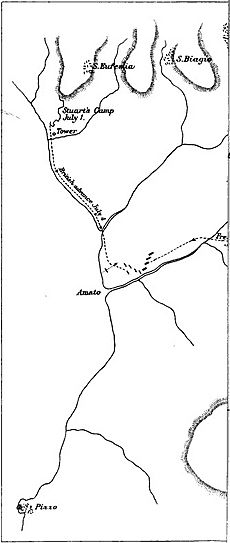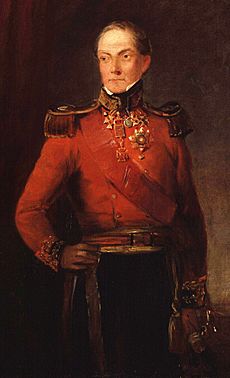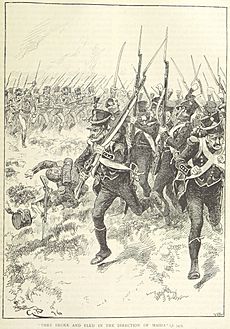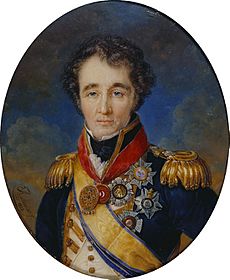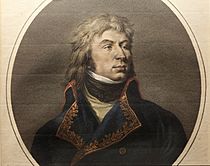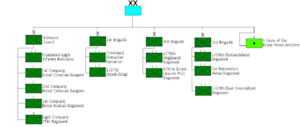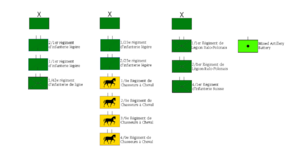Battle of Maida facts for kids
Quick facts for kids Battle of Maida |
|||||||
|---|---|---|---|---|---|---|---|
| Part of the French invasion of Naples | |||||||
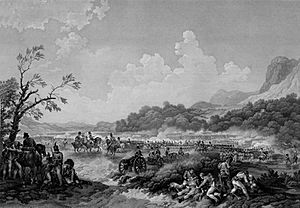 Battle of Maida, Philip James de Loutherbourg |
|||||||
|
|||||||
| Belligerents | |||||||
|
|||||||
| Commanders and leaders | |||||||
| Strength | |||||||
| 5,236 | 6,440 | ||||||
| Casualties and losses | |||||||
| 45 killed 282 wounded |
490 killed 870 wounded 722 captured |
||||||
The Battle of Maida was a big fight that happened on July 4, 1806. It was part of the Napoleonic Wars, a series of major conflicts across Europe. This battle took place near the town of Maida in Italy.
British and Sicilian soldiers, led by General John Stuart, fought against French, Italian, and Polish troops. The French forces were commanded by General Jean Reynier. General Stuart's army had about 5,200 soldiers. General Reynier's army had around 5,400 soldiers. The British and their allies won a clear victory, causing many more losses to the French side. Maida is located in the southern part of Italy, about 30 kilometers (19 miles) west of Catanzaro.
Earlier in 1806, French forces had taken over the Kingdom of Naples. This forced King Ferdinand I of the Two Sicilies to escape to Sicily. The people in Calabria (a region in southern Italy) started a rebellion against the French. The British sent General Stuart's army to help these rebels and stop the French from invading Sicily. During their mission, the British soldiers met Reynier's French division, and a battle began.
After the battle, General Stuart captured some French bases in Calabria. Then, the Royal Navy took his troops back to Sicily. Even though the British won at Maida, the city of Gaeta fell to the French two weeks later after a long siege. Stuart's victory helped protect Sicily from a French invasion and kept the rebellion going in Calabria.
Contents
Why the Battle Happened
French Invasion of Naples
In 1806, King Ferdinand of Naples decided to join the Third Coalition. This group of countries was against Napoleon I of France. Because of this, French armies invaded the Kingdom of Naples. British and Russian soldiers who were supposed to defend Naples left Italy. The British went to Sicily, and the Russians went to Corfu.
The Neapolitan-Sicilian army was defeated in a battle called Battle of Campo Tenese. This made King Ferdinand flee to Sicily. Napoleon then made his brother, Joseph Bonaparte, the new king of Naples.
British Expedition to Calabria
By July 1806, the French had put down most of the resistance in Naples. Only the uprising in Calabria and a small group of soldiers in Gaeta were still fighting. A French army, led by André Masséna, was busy trying to capture Gaeta.
The British decided to send an army to Calabria. Their goal was to support the rebellion against the French. They also wanted to stop the French from trying to invade Sicily.
The Battle of Maida
On June 27, a British force of over 5,000 soldiers left Messina. They were led by Major-General John Stuart. Three days later, they landed in the Gulf of Sant'Eufemia. At the same time, a French army under General Jean Reynier moved to meet them. Reynier's army was the only French force in Calabria. The exact number of French soldiers is not fully known. Some reports say between 5,050 and 5,450. More recent studies suggest around 5,400.
Armies Meet
On the morning of July 4, Reynier's army left their camp. They moved towards a flat area near the shallow Lomato River. General Stuart believed his army was larger than the French. So, he marched his troops towards the same spot. Both armies spread out from their marching lines. They ended up in a special formation called an echelon formation. This means parts of the army were lined up like steps.
On the French side, the left part of their army was ahead. On the British side, the right part was ahead. On the French left, General Louis Fursy Henri Compère was leading. His group included the 1st Light Infantry and the 42nd Line Infantry. In the middle, General Luigi Gaspare Peyri commanded two Polish battalions and a Swiss battalion. On the right, General Antoine Digonet was behind the others. His group had the 23rd Light Infantry, some cavalry, and cannons.
British and French Formations
Opposite the French, Colonel James Kempt's Advanced Guard was on the British right. They were also ahead. Behind Kempt was Colonel Wroth Palmer Acland's 2nd Brigade. Further back and to Acland's left was Colonel John Oswald's 3rd Brigade. Colonel Lowry Cole's 1st Brigade was on the far left with the artillery. Cole's group was closer to the French than Oswald's. The 20th Foot regiment was doing other tasks and arrived late.
General Stuart only realized his army was smaller when they were very close to the French. But he let the battle begin without changing his plans. Kempt sent out some Royal Corsican Rangers and Sicilian soldiers. These were "skirmishers," who fight in loose groups. They got into a small fight with French light soldiers called voltigeurs and then fell back. Kempt sent more soldiers to help. Once the British stopped the French skirmishers, they rejoined Kempt's main group.
The Fight Begins
At this point, General Compère sent his 1st Light Regiment to attack Kempt. The 42nd Line Regiment aimed for Acland's group. The 1st Light Regiment attacked first. When they were about 150 yards away, Kempt's Advanced Guard fired their first volley (a group of shots). But the French kept coming. Kempt's second volley was fired when the French were 80 yards away. This shot wounded General Compère, but he still urged his men forward.
Even though they had lost soldiers, the French got within 20 yards. There, they were hit by a third volley. This volley completely broke the 1st Light Regiment. Its soldiers turned and ran away. General Compère, who rode right into the British line, was captured.
As the 1st Light's attack failed, Kempt's men charged their shaken enemies. The French formation fell apart. Kempt's Advanced Guard chased the fleeing French all the way to Maida. Meanwhile, the 42nd Regiment advanced on Acland's group. The British fired at them from 300 yards away. They kept firing until the French attack stopped. The 42nd Regiment saw their neighboring regiment running away, so they also left the field.
French Retreat
Seeing his left side defeated, Reynier sent Peyri's brigade to face Acland. After a quick fight, the Polish soldiers were defeated by bayonets. However, the Swiss soldiers kept their order and fought well. After Stuart sent more soldiers to help, the Swiss battalion slowly moved back to join Digonet's brigade.
Acland and Cole now moved towards Digonet and the Swiss. The 9th Chasseurs (French cavalry) charged, forcing the British soldiers to form a square for defense. Oswald's brigade then arrived. But Digonet still held his ground, supported by cavalry and cannons. Finally, the 20th Foot regiment arrived from the coast. They started firing at the exposed right side of the 23rd Light Regiment. At this, Digonet and the Swiss began an orderly retreat, and the battle was over.
Casualties
General Stuart's army had 5,196 soldiers. They lost 45 killed and 282 wounded, for a total of 327 casualties. General Reynier's army had 6,440 soldiers. They lost 490 killed and 870 wounded. The British also captured 722 French soldiers and four cannons. Some say the French managed to save their cannons. The 1st Light Infantry Regiment lost half of its soldiers (killed, wounded, or captured). The main fight involving the 1st Light Infantry lasted only fifteen minutes.
After the Battle
After the battle, Stuart told Kempt's Advanced Guard to watch Reynier's retreat. Stuart and Admiral Sidney Smith then discussed what to do next. On July 6, they decided to move south and capture Reynier's small bases. That day, some Polish-Italian soldiers in Vibo Valentia surrendered to Stuart. On July 7, three more companies of Polish soldiers gave up in Tropea. This happened when Captain Edward Fellowes on the frigate HMS Apollo called for their surrender.
Reggio Calabria surrendered on July 9 to Brigadier General Broderick. He had 1,200 British and Neapolitan troops. These allies were brought from Sicily by the frigate HMS Amphion. In this event, 632 soldiers from the 1st Light and 42nd Line Infantry Regiments were captured.
Stuart marched south and reached Reggio on July 23. Before going back to Sicily, he and Smith cleared out all of Reynier's bases in southern Calabria. On July 24, the fortress of Scilla and 281 soldiers surrendered to Oswald. The British had soldiers from the 10th Foot, 21st Foot, and Chasseurs Britanniques regiments. The 3rd battalion of the Polish-Italian Legion, with 500 soldiers, surrendered to Captain Hoste and the 78th Foot at Crotone on July 28. For his victory, Stuart received a special award called the Order of the Bath. He also got £1,000 a year from the British crown and the title Count of Maida from King Ferdinand.
Gaeta Falls
The allies faced a big problem on July 18. The long Siege of Gaeta ended. After French cannons broke through Gaeta's walls, the Neapolitan soldiers there gave up. By marching south, Stuart and Smith missed a chance to help Gaeta. They also missed a chance to land at Naples and try to overthrow Joseph Bonaparte's government.
The surrender of Gaeta freed up Masséna's French army for operations in Calabria. However, Stuart's expedition had achieved its main goal. It stopped any early French invasion of Sicily. It also kept the rebellion going in Calabria, which the French did not fully control until 1807.
The political situation in southern Italy stayed the same until 1815. British and Sicilian troops guarded King Ferdinand in Sicily. The Napoleonic King of Naples controlled the mainland. The British did not fully use their strong navy around Italy. They did little to bother the French on the mainland. In 1808, Joachim Murat became the King of Naples. This happened after Joseph Bonaparte was sent to rule Spain. Murat tried several times to cross the Strait of Sicily, but he always failed. It was not until Austria defeated Murat in the Neapolitan War in 1815 that King Ferdinand finally got his throne back.
Legacy of Maida
The Battle of Maida is remembered in several ways:
- Maida Hill and the areas of Maida Vale in London, England, are named after this battle.
- Maida Vale in Perth, Western Australia, is also named after it.
- The Royal Navy named a recently captured French ship HMS Maida in 1806.
How the Armies Were Organized
| British Order of Battle | French Order of Battle |
|---|---|
|
Major General John Stuart (236 officers, 4,960 men)
|
Général de Division Jean Reynier (6,029 men)
|
What We Know About the Battle Now
Columns vs. Lines
For a long time, people thought that in the Battle of Maida, the British fought in a "line" formation. They believed the French attacked in "columns." In this old view, the British line could fire many shots at once into the French column. Only the first few rows of the French column could fire back. This was like a naval tactic called "Crossing the T."
However, modern historians disagree with this idea. Military historian James R. Arnold explains that earlier historians like Sir Charles Oman and Sir John Fortescue shaped how people understood Napoleonic battles. Their idea was that French infantry always attacked in heavy columns against British lines.
But by 1998, new books on battle tactics came out. These books suggested that the French actually fought in lines at Maida. They showed that French tactics were more varied. A 2002 book, The Battle of Maida 1806: Fifteen Minutes of Glory, seemed to settle the debate. It stated that "The contemporary sources are...the best evidence and their conclusion is clear: General Compère's brigade formed into line to attack Kempt's Light Battalion." The main part of the battle at Maida lasted less than fifteen minutes. It took 72 years to correct a mistake about what happened in those few minutes.
The British soldiers fired many shots (volleys) and then charged with their bayonets. The French could not stand against this attack. They broke and ran, losing many soldiers as they fled.
Charles Oman's View
Despite the criticism, military historian Charles Oman himself wrote in his 1913 book:
“It is not enough to simply say that Wellington fought against troops who always used columns, and he beat them by meeting them with troops who always fought in two-deep battle lines. This statement is generally true, but it needs more explanation and changes."
"A clear example of how well the two-deep line worked against the three-deep line was seen at the battle of Maida. This battle in Calabria happened three years after the start of the second half of the great French War. In this fight, the French General Reynier had spread out most of his battalions into a line. They were not fighting in their usual mixed order or in battalion columns. The result was very clear. 5,000 British infantry in the thinner formation faced 6,000 French in the heavier formation. The British won a crushing defeat, purely by firing better. They killed or captured 2,000 men, while only losing 320 of their own. It's worth remembering that some officers who later became trusted leaders for Wellington were at Maida. These included Cole, Kempt, Oswald, and Colborne. This was almost the only time I know where English and French armies fought both in lines, facing each other. Usually, it was 'column against line'."


